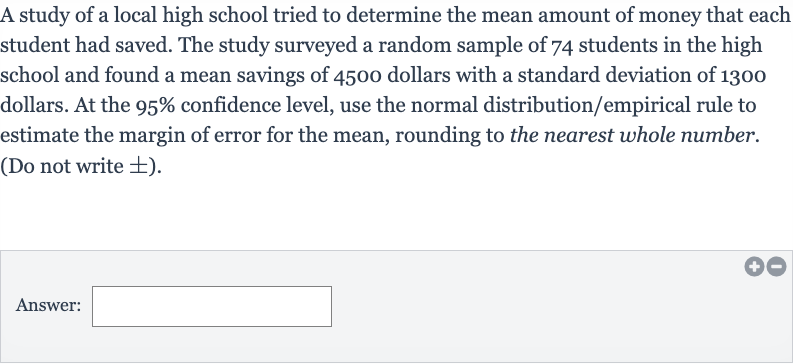AI tutor
Welcome to Bytelearn!
Let’s check out your problem:

A study of a local high school tried to determine the mean amount of money that each student had saved. The study surveyed a random sample of students in the high school and found a mean savings of dollars with a standard deviation of dollars. At the confidence level, use the normal distribution/empirical rule to estimate the margin of error for the mean, rounding to the nearest whole number. (Do not write ).Answer:
Full solution
Q. A study of a local high school tried to determine the mean amount of money that each student had saved. The study surveyed a random sample of students in the high school and found a mean savings of dollars with a standard deviation of dollars. At the confidence level, use the normal distribution/empirical rule to estimate the margin of error for the mean, rounding to the nearest whole number. (Do not write ).Answer:
- Identify Given Values: Identify the given values from the problem.We are given:- Mean savings () = \(4500\)\(\newline\)- Standard deviation (\(s\)) = - Sample size () = - Confidence level = %
- Determine Confidence Level: Determine the z-score that corresponds to the confidence level.For a confidence level, the z-score that corresponds to the confidence interval is approximately . This is because of the data falls within standard deviations from the mean in a normal distribution.
- Calculate Margin of Error: Calculate the margin of error using the formula for the margin of error at a given confidence level.The margin of error (E) is calculated using the formula:where is the z-score, is the standard deviation, and is the sample size.
- Calculate Margin of Error: Plug in the values and calculate the margin of error. (rounded to four decimal places for the square root of ) (rounded to four decimal places for the division)
- Round Margin of Error: Round the margin of error to the nearest whole number.The margin of error rounded to the nearest whole number is .
More problems from Use normal distributions to approximate binomial distributions
QuestionGet tutor help
QuestionGet tutor help
QuestionGet tutor help
QuestionGet tutor help
QuestionGet tutor help
QuestionGet tutor help
QuestionGet tutor help
QuestionGet tutor help
QuestionGet tutor help
QuestionGet tutor help
